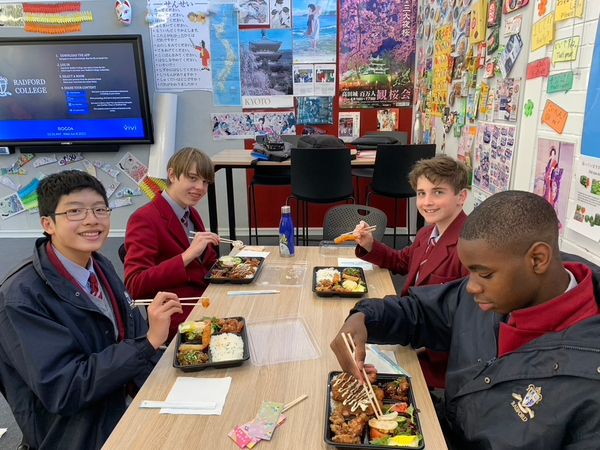A taste of Japan for Year 9 students
By Michele Sharp, Head of Languages
Recently in Year 9 Japanese, students created media oral assessments and have been learning about the importance of Japanese eating etiquette.
Learning a language is as much about learning about culture as it is grammar and vocabulary. Understanding cultural norms is a very important part of everyday communication, and the students were surprised to learn just how many ‘rules’ there are when eating with chopsticks.
Whilst eating our Japanese lunch, we viewed the videos the class had made for their oral assessment this semester. I was amazed, yet again, at the creativity with which the students expressed their messages in their mini movies and am pleased to share two very different examples with the community in this article. I hope you enjoy their work as much as our class did. The task involved students:
- saying when and where they do activities
- saying how they get to places
- saying who they are going with, and
- using adjectives to describe and a variety of verb tenses.
Watch the student videos by Matt Morey and Saanvi Talluri.
Student reflections by Iona Brighton and Tilly O’Sullivan, Year 9
On 8 June, our Year 9 Japanese class celebrated the end of the term with an おべんとう(obento) lunch. The day gave us an opportunity to eat some delicious Japanese food, whilst watching our peers' media orals that we had recently completed as part of an assessment.
In Japan, an obento is not just food, but an art form. It displays food in creative, fun, and beautiful ways that allow us to truly appreciate the effort behind each step of production. This notion is also encapsulated in the term いただきます (itadakimasu) – said before eating in Japan, that acknowledges the hard work put into your meal.
Prior to the day, we had been learning about the proper etiquette and manners expected when dining with chopsticks (おはし/ohashi). Chopsticks aren’t just eating utensils, eating with them requires a set of rules to follow. We have learnt that there is some ‘leeway’ given to foreigners, but it is always best to be educated on social rules and practices.
We learnt about the dos and don’ts when eating with chopsticks. These don’ts include:
sashi bashi – stabbing or skewering food with chopsticks, pointing towards someone with chopsticks
tate bashi – sticking your chopsticks into rice
hashi watashi – passing food between each other using chopsticks
nigiri bashi – grabbing the chopsticks in a closed fist like a weapon
chigiri bashii – cutting food into smaller pieces by using the chopsticks like a knife and fork
yose bashi – pulling a dish towards you using chopsticks
kuwae bashi – holding chopsticks in your mouth
neburi bashi – licking your chopsticks
tataki bashi – hitting your chopsticks against a dish
saguri bashi – rummaging through the dish to find a part you will like
mayoi bashi – hovering the chopsticks over food while you decide what you want
sakasa bashi – not using communal chopsticks when transferring food from shared platters onto your plate; using your own chopsticks is seen as unclean
soroe bashi – lining up your chopsticks by tapping them on the table, you must use your other hand to line them up
Always keep your chopsticks parallel when resting them, having them crossed symbolises death!

It’s beneficial for all wanting to travel to Japan to know these rules, this would stop the embarrassment of accidentally offending people. We have all enjoyed this learning experience so much, we also can’t wait to continue learning about Japanese culture.
When learning about proper etiquette, we also had the opportunity to practise our chopstick skills by picking up jellybeans. For this activity, we also made おりがみ(origami) chopstick holders that we used to keep our わりばし (disposable chopsticks) in, so we didn’t have to throw them out. Japan uses around 24 billion pairs of disposable chopsticks each year, and the production can be harmful to the environment through activities such as deforestation. Hence, ensuring our chopsticks were kept clean and reusable was important.
Overall, the experience was very enjoyable. It gave us an insight into the intricacies of Japanese dining and allowed us to enjoy some amazing food. Thank you very much to Bento Tei in Gungahlin for making meals, and to Sharp Sensei for organising the day.
